
by Spreck | Nov 15, 2021 | Uncategorized

From left to right, Cherry, Eleanor and Hetch Hetchy – San Francisco’s three “upcountry” reservoirs. The City also stores water in Don Pedro, downstream on the Tuolumne River, and five reservoirs in the Bay Area. Hetch Hetchy Reservoir is a significant, but wholly replaceable, piece of the system.
Sunday’s editorial in the San Francisco Chronicle strongly urged Dennis Herrera, the newly elected General Manager of the City’s Public Utilities Commission, to invest in alternative supplies and lessen the harm to habitats and wildlife caused by its diversions. It’s a positive thing that the Chronicle understands that San Francisco, like all cities and farms, cause harm when water is diverted from the natural world.
For those without a subscription, the editorial includes the following vignettes:
- “Conservation won’t be enough. We still need to diversify our water portfolio.”
- “There are rivers upon rivers of untapped, drought-resistant fresh water waiting to be captured — our treated sewage outflows.”
- “Orange County has the sewage recycling capability to meet the water needs of 1 million residents. There is a not a single environmental sustainability metric in which San Francisco should be trailing Orange County.”
- “Herrera has signaled that he’s up to the challenge. San Francisco residents need him to mean it.”
Unfortunately, however, the Chronicle continues its myopia when it comes to Hetch Hetchy. The City’s favorite reservoir is included in the editorial but not associated with the harm the water system has caused. The Chronicle thus continues its long history of supporting aquatic restoration just about everywhere throughout California with the exception of Yosemite – for a few decades of examples of this double standard, see here).
At Restore Hetch Hetchy, we understand the inclination of some San Francisco leaders to hold on to the special (and unprecedented) deal it made with Congress in 1913. It’s time for a paradigm shift. As a whole, San Franciscans need to recognize and undo the harm they have done to Yosemite.
Here’s our letter to the Chronicle – we hope they will print it:
Dear Editor:
San Francisco, like most of California’s cities and farms, do indeed cause harm to habitat and wildlife by diverting water from Sierra rivers. The Chronicle is right that the time to diversify the City’s portfolio with sustainable alternatives, such as recycling, in now.
San Francisco, however, stands alone as the only city in the United States to have inflicted such harm in a national park – something it did a century ago when it clear-cut, dammed and flooded Yosemite’s Hetch Hetchy Valley. Government agencies, universities and environmental groups have all shown that investments in recycling or groundwater storage would keep water supplies whole while allowing Hetch Hetchy to be returned to a natural and wild state. The time to reclaim all of Yosemite is now as well.
Spreck Rosekrans, Executive Director, Restore Hetch Hetchy
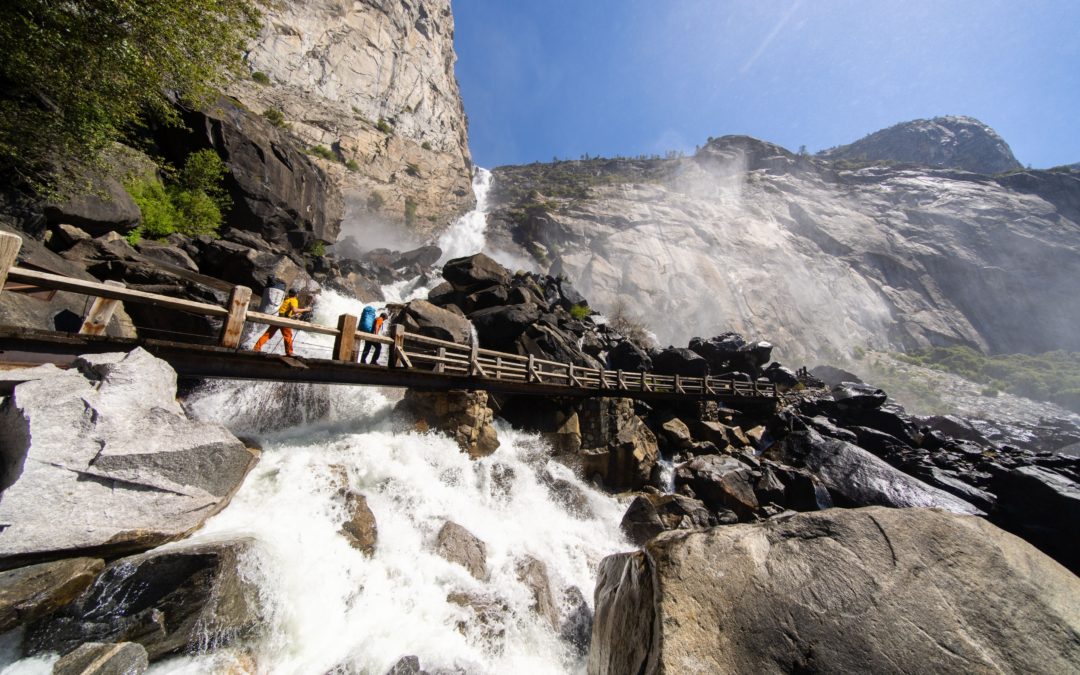
by Spreck | Nov 7, 2021 | Uncategorized
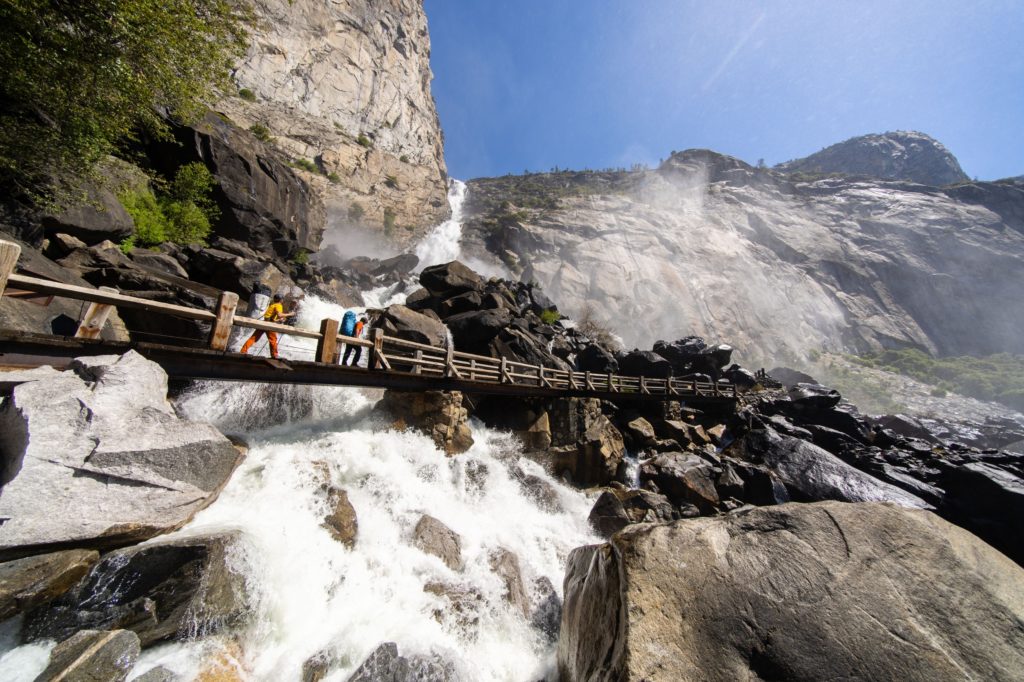
Storm flows that damaged the bridges at Wapama Falls were roughly 5 times as high as the spring snowmelt in May 2021 (shown above).
The seasonally rare “Bomb Cyclone” storm, which drenched northern California during the fourth week of October, hit Hetch Hetchy at 4 AM on October 24 and Yosemite Valley three hours later. Steady rain over thirty hours totaled 5 inches at Hetch Hetchy and 6 inches in Yosemite Valley.
Yosemite’s waterfalls, bone dry at the end of the summer in a drought year, came to life as did creeks and rivers throughout the state. Pictures of Yosemite Falls were gleefully posted all over the World Wide Web.
Photos of Wapama Falls were not available as the storm damaged the bridges at its base and the National Park Service was forced to deny visitor access to protect safety. So presently, as has too often been the case in recent years, hikers are not able to really see Wapama or to hike beyond it.
The Park Service plans to reopen the trail soon. We hope that to be true, as the rain has abated and fall has brought great hiking weather.
The Park Service has also been working on a long-term repair and relocation of the bridges at Wapama. We hope one day soon they can be open every day of the year – or only closed to the public on very rare occasions.
As we explained in Keeping Promises: Providing Public Access to Hetch Hetchy Valley, Yosemite National Park, Restore Hetch Hetchy believes the National Park Service has an obligation to provide the level of visitor access assured by the letter and spirit of the controversial Raker Act in 1913. A better bridge at Wapama is long overdue, since Hetch Hetchy Reservoir has eliminated access across the valley. We also continue to support a quiet, electric, non-polluting tour boat to show visitors the entire Hetch Hetchy canyon and transport them to trailheads along the reservoir’s shore (an idea San Francisco used to entreat Congress to allow construction of the dam and reservoir).
We can only guess what the peak flow of Wapama Falls was during the storm. There is an upstream flow gage, but it does not measure values over 1000 cubic feet per second. As shown in Chart 1, however, the flow gage for Wapama (aka Falls Creek) were similar to those at Happy Isles Bridge on the Merced River at the beginning and end of the storm so the peak flow may have reached a similar value – roughly five times that of the snowmelt flows last May (shown in the photo above).
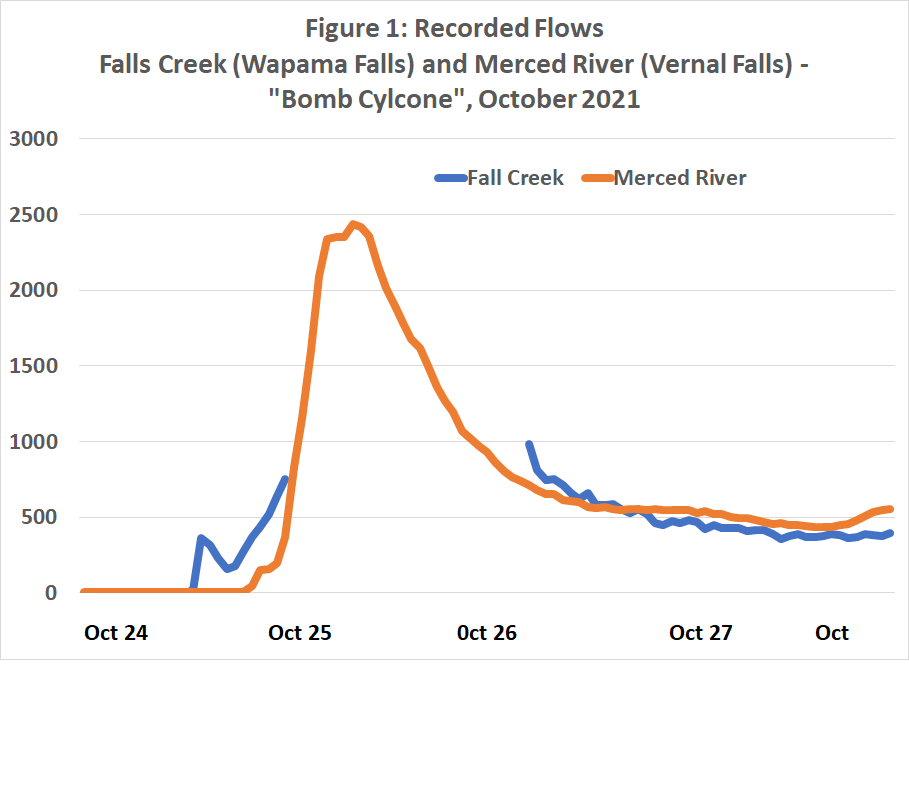
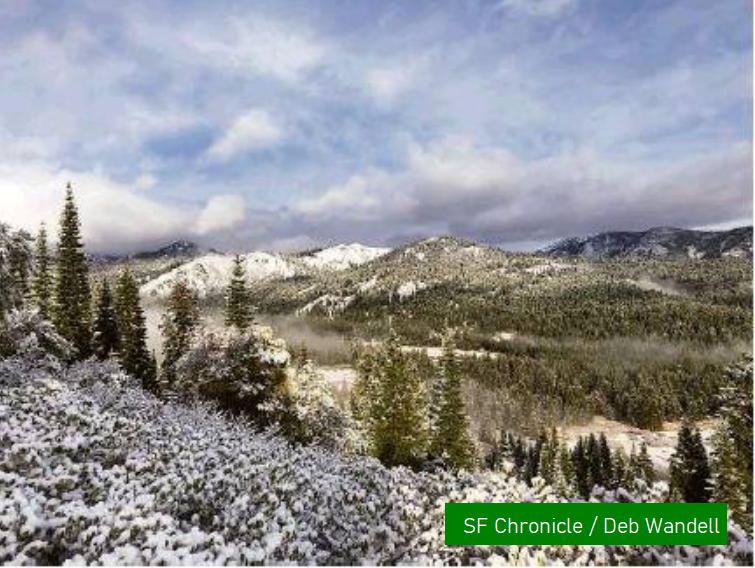
by Spreck | Oct 9, 2021 | Uncategorized
A smattering of rain and snow in early October gives us hope that 2022 will be a wet year and our two year drought will come to an end. Maybe it will, and maybe it won’t.
2020 was dry. 2021 was one of the very driest years we’ve seen over the last century.
Moreover, groundwater levels have continuously declined, so it is increasingly difficult to rely on our aquifers when precipitation is scarce. Wells have gone dry across the state. Many small Central Valley communities rely solely on groundwater (and the quality can be unfit to drink even when it is available). Cities on the Mendocino Coast have resorted to bringing in water by truck water for the past month, as wells have gone dry.
Conditions in California’s larger urban centers vary. Marin County is considering building a permanent pipeline across the Richmond – San Rafael Bridge (Marin built such a pipeline in 1977 but removed it a few years later). Zone 7, which relies on the State Water Project supplies and limited local groundwater to serve Pleasanton and Livermore, is requiring customers to cut back. And Valley Water, the Bay Area’s largest supplier serving the South Bay, has told its customers that Santa Clara County is “in an extreme and exceptional drought.”
For the most part, urban southern California is faring better. The Metropolitan Water District of Southern California and its customers have built local surface storage, invested heavily in recycling and has stored groundwater locally, in the Central Valley and in the Mojave Desert. The East Bay Municipal Utility District will be accessing additional supplies from the Sacramento River through its diversion facility at Freeport – a project completed just a decade ago.
San Francisco’s Regional Water System is also in pretty decent shape. The SFPUC reports it has 980,563 acre-feet in its nine reservoirs – roughly enough to supply its customers for four years even if its does not rain a drop. See Figure 1.
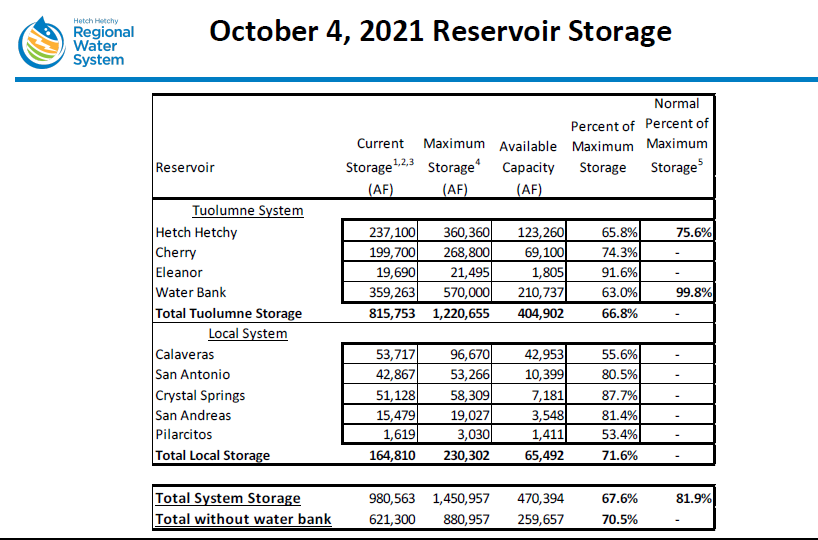
Restoring Hetch Hetchy Valley in Yosemite National Park will not mean any reduction in water supply or any loss of reliability. For example, the San Francisco Public Utilities Commission could invest in groundwater recharge to replace the storage function of Hetch Hetchy Reservoir, as so many of California’s cities have done over the last 30 years (see Figure 2). The battle to convince leaders in San Francisco is partly economic, but mostly political. Not a drop of water need be lost!
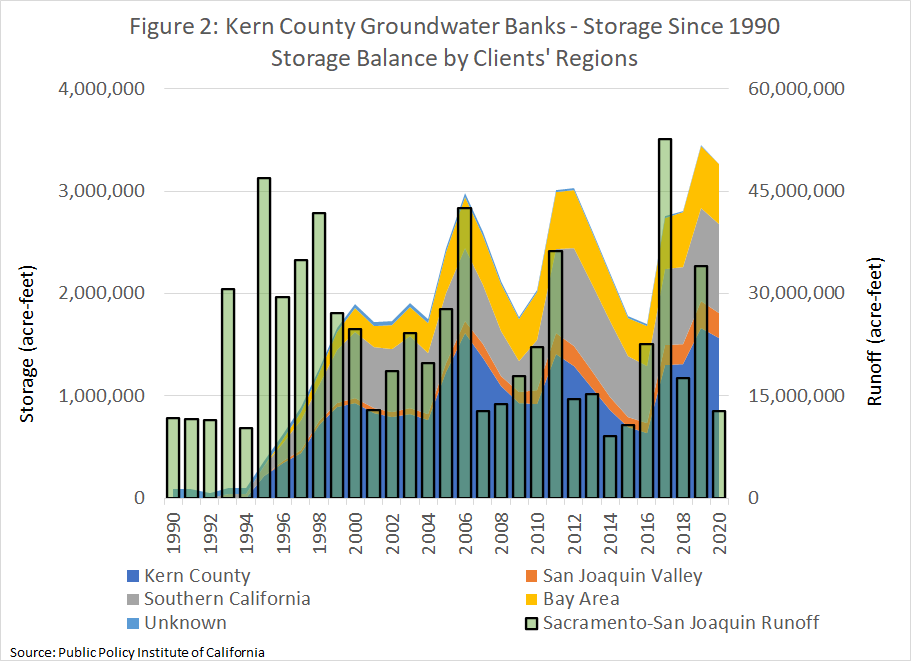
Since modest investment in the early 1990’s Kern County’s groundwater banks have provided substantial benefits for farmers and cities alike. Figure 2 shows the aquifers are recharged in years when river runoff is high, and those supplies are then withdrawn in drier years.
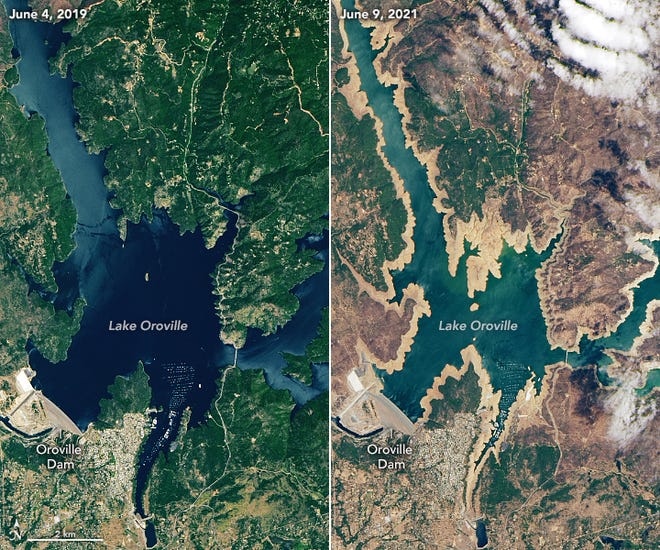
by Spreck | Sep 3, 2021 | Uncategorized
2021 is the 4th driest year since 1906, and last year was dry as well. Two dry years make a drought these days, especially since our aquifers are more depleted than ever. Here’s hoping 2022 will be a gully washer and may it come soon.
In droughts, California’s historically based system of allocating water “rights” comes into play. While everyone may suffer, the pain is not equally shared. Examples below include the federal Central Valley Project’s San Joaquin Valley customers, water users on the Stanislaus River and water users on the Tuolumne River (which includes, of course, the San Francisco Public Utilities Commission and its Hetch Hetchy Reservoir).
Figure 1 below shows storage levels in Shasta Reservoir, the largest in California, and selected Central Valley Project deliveries to the San Joaquin Valley, including (1) Exchange Contractors, (2) Wildlife Refuges and (3) Westlands Water District for the ten-year period from 2011-2020. The Exchange Contractors are farmers who originally had senior rights on the San Joaquin River but “exchanged” them for water delivered from northern California and through the Delta. The Central Valley Project Improvement Act, passed in 1992, includes provisions to deliver water to managed wetlands in the San Joaquin Valley to mitigate, in part, for the wetlands that were dried up to make room and provide water for agriculture. Both the Exchange Contractors and Wildlife Refuges have priority that is senior to the “Water Service” contractors, whose water supply is available only when the needs of senior rights holders have been met.
Westlands Water District is the largest of the Water Service Contractors. Much of the land is very productive, but Westlands has junior water rights and has historically relied on litigation to get every drop of water possible. Farmers in Westlands often grow a mix of lower value annual “row” crops (e.g. tomatoes) and higher value orchard crops (almonds etc.). They will often fallow the annual crops in dry years and use what water they are allocated or can buy for their orchards. Many have been very successful with this strategy but some have also gone bankrupt.
As Figure 1 shows, deliveries to the Exchange Contractors and Wildlife Refuges are mostly consistent, but deliveries to Westlands plummet in dry years.

Figure 2 shows New Melones Reservoir and operations on the Stanislaus River. Completed circa 1980, New Melones Reservoir was the last major on-stream reservoir constructed in California. It is also part of the Central Valley Project, but it is operated for the benefit of farms near the Stanislaus River. Part of the agreement prior to the construction of New Melones Reservoir included assurances the rights of the Oakdale and South San Joaquin Irrigation Districts would be met before deliveries to others would be made. (Releases from New Melones are also used to meet dilute salt loads in the south Delta.) When there is extra water available, modest deliveries to the Stockton East Water District are made. Figure 2 also shows that New Melones was nearly empty in 2015.

Figure 3 provides a synopsis of water storage and the distribution of water rights on the Tuolumne River from 2011 until 2020. Don Pedro is the largest reservoir on the Tuolumne, but Hetch Hetchy, Cherry and Eleanor Reservoirs provide additional storage capacity. The Turlock and Modesto Irrigation Districts use about 4 times as much of the river’s water as does the San Francisco PUC, but roughly one-half of all the surface storage belongs to San Francisco. San Francisco relies on this storage to meet its needs in dry years when its water rights are minimal (see 2012-2015 and 2020 below).
As a result of its extraordinary investment in storage, the San Francisco PUC has a very reliable system (but like all water agencies, they rightfully worry about extended droughts). As a result of San Francisco’s practices, storage in Tuolumne River reservoirs is generally kept at relatively high levels.
Restore Hetch Hetchy is keenly ware of San Francisco’s rights, demands and other facilities as we pursue and advocate for groundwater banking, recycling and other alternatives will replace the water supply function of Hetch Hetchy Reservoir.

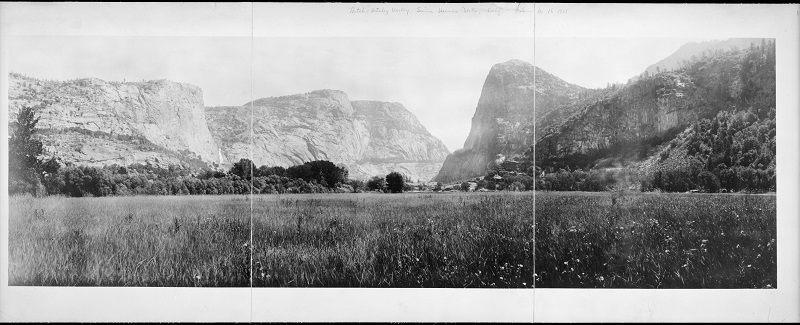
by Spreck | Aug 30, 2021 | Uncategorized
Saturday’s New York Times carried an excellent guest essay by Kyle Paoletta, making the point that our national parks are in great demand and often overcrowded, and that we need more of them. As Paoletta notes, “more than 327 million people visited the public lands managed by the National Park Service in 2019” and too often “Going to a national park in 2021 doesn’t mean losing yourself in nature. It means inching along behind a long line of minivans and R.V.s on the way to an already full parking lot.”
The New York Times may be situated in America’s largest and densest city, but it has long championed open space and national parks. In 1913, the Times ran 6 editorials in opposition to the proposal to dam Yosemite’s Hetch Hetchy Valley. The New York Times was not alone. National parks were fairly new at the time, but more than 100 newspapers across the country opposed the Raker Act: The Journal of Lincoln Nebraska said the following:
A representative of the city was asked if they could not get the abundant and pure water in some other part of the Sierra Range than the Hetch Hetchy Valley. “Yes,” he said, “by paying for it”. There we have the milk in the cocoanut. And Congress seems determined to give the wild part of Yosemite away just because a rich and influential city wants it.
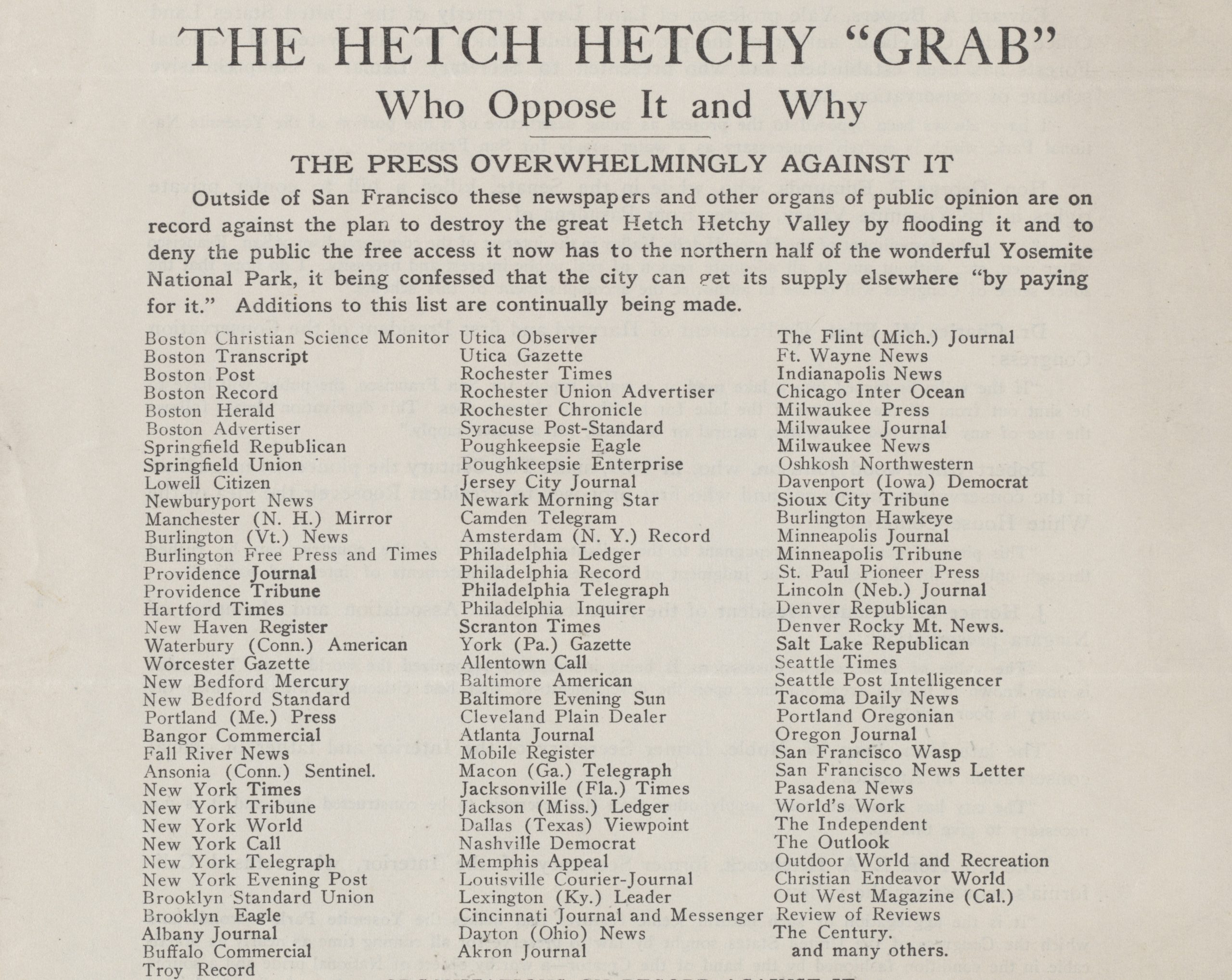
It seemed like a good opportunity to send a letter to the editor. We hope they will print it.
Re “Give the People What They Clearly Need: More National Parks” by Kyle Paoletta (guest essay, Aug. 28):
There is no better start to improving America’s national parks than reversing the damage to Yosemite National Park, now more than a century old.
Overcrowded Yosemite Valley is one of the world’s most popular natural attractions, drawing 4 million people annually. But Hetch Hetchy, the other spectacular glacier-carved valley inside the same great national park, was dammed and flooded by San Francisco in 1923 after bitter infighting in Congress – the only time any national park anywhere in the U.S. has been so hijacked for outside exploitation. Moreover, access to the Hetch Hetchy area of Yosemite has been further restricted, to “protect” San Francisco’s reservoir, so only a few thousand visitors a year get to see it.
The National Park Service should increase common-sense visitor opportunities at Hetch Hetchy. Better yet, San Francisco should be prodded to invest in water storage downriver, outside the Park’s boundaries.
Spreck Rosekrans, Executive Director
Restore Hetch Hetchy

by Spreck | Aug 22, 2021 | Uncategorized
At Restore Hetch Hetchy, we care about reliable water supplies for all communities, but we pay particular attention to San Francisco. After all, restoration can only be accomplished if water supplies for the San Francisco’s and its wholesale customers are undiminished. Fortunately, this can be accomplished,. As we have said over and over, not a drop need be lost when Hetch Hetchy Reservoir is emptied and the valley is restored. For more information on the solutions we recommend, see our Summer Newsletter or Water and Power System Improvements Necessary to Accommodate Restoration of Hetch Hetchy Valley in Yosemite National Park (2018).
Fortunately, San Francisco’s water system is in good shape. The City’s supplies in its Tuolumne watershed reservoirs are substantial, and are designed to last through a lengthy drought. Water managers cannot be blamed, however, for worrying about extended droughts – that’s their job.
Figure 1 provides a snapshot of San Francisco’s water rights over the last three years, along with its average diversions to the Bay Area and its storage capacity in the Tuolumne Watershed. Water Year 2019 was good to San Francisco, providing more than enough flow to fill Hetch Hetch Hetchy Reservoir, Cherry and Eleanor Reservoirs, and the City’s water bank in Don Pedro Reservoir.
2020 was a dry year and San Francisco’s water rights yielded less than its need to divert water to the Bay Area, so it needed to withdraw about 60,000 acre-feet from its stored supplies (evaporation and losses play a small role in the need for storage withdrawal as well).
2021 has been critically dry and San Francisco’s junior water rights on the Tuolumne River have provided only 44,873 acre-feet of supply (The Turlock and Modesto Irrigation Districts have senior rights and are entitled to more than 10 times as much of the river’s flow in 2021.) So this year, San Francisco will need to draw down its storage by 180,000 acre-feet or so.
Still San Francisco’s system will be in good shape even if the drought persists another year. But for everybody’s sake, we hope water year 2022 (which begins October 2021) will be good and wet. And for the sake of the fires, let’s hope the rain comes early as well.















